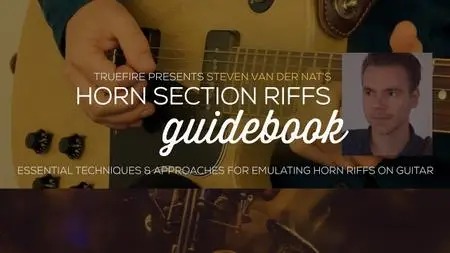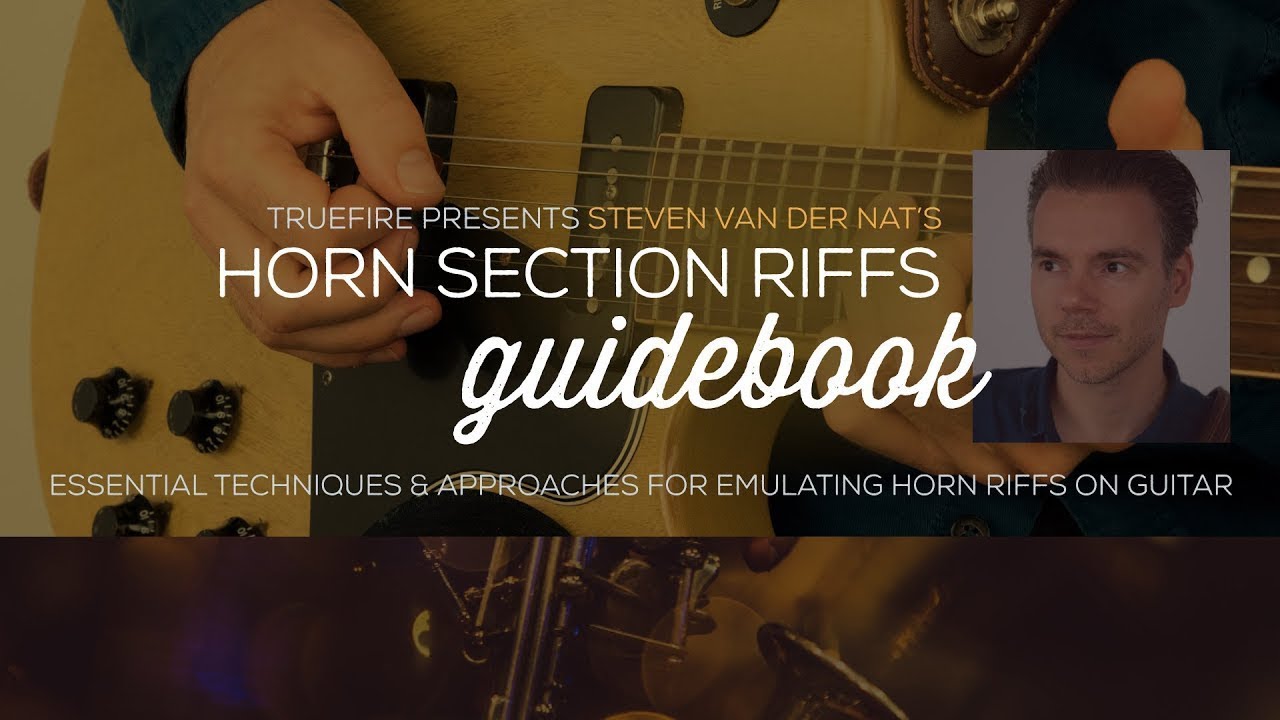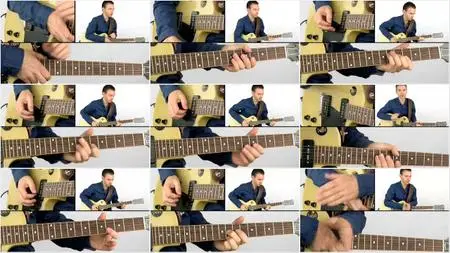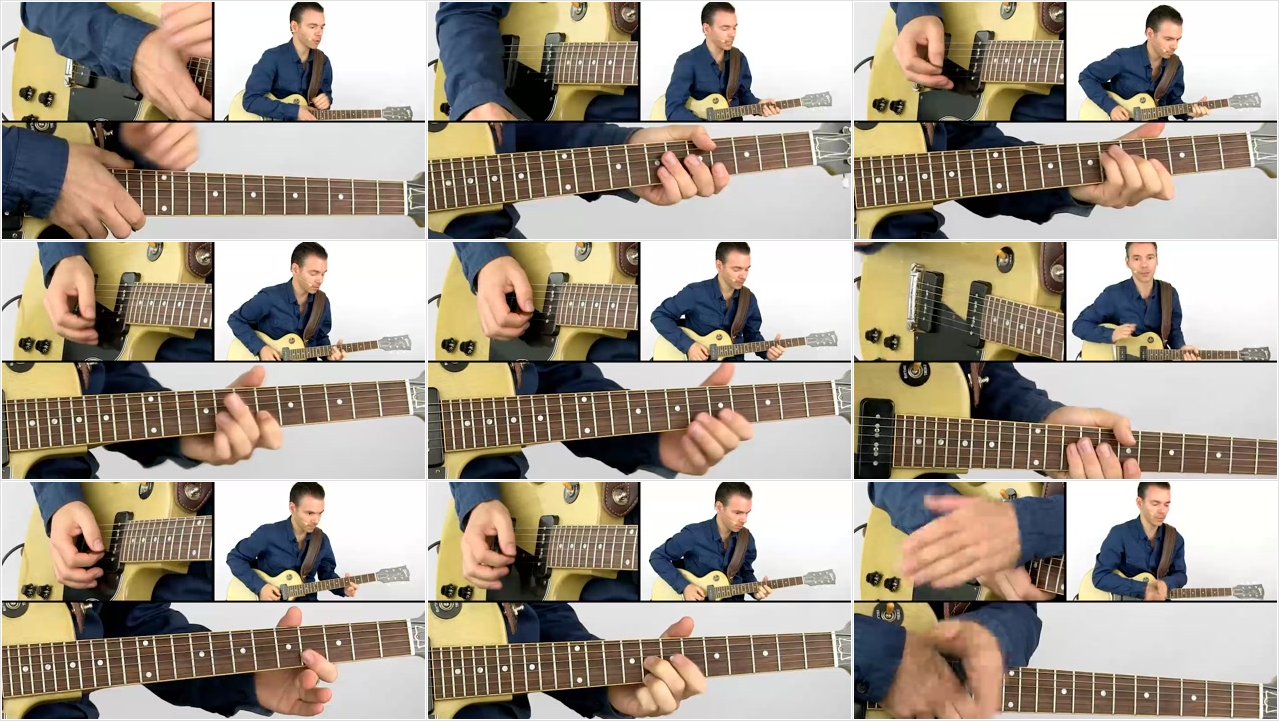Horn Section Riffs Guidebook
.MP4, AVC, 650 kbps, 960x540 | English, AAC, 128 kbps, 2 Ch | + Charts (.pdf), Jam Tracks (.mp3) | 1h 13m | 446 MB
Instructor: Steven van der Nat
.MP4, AVC, 650 kbps, 960x540 | English, AAC, 128 kbps, 2 Ch | + Charts (.pdf), Jam Tracks (.mp3) | 1h 13m | 446 MB
Instructor: Steven van der Nat
Essential Techniques & Approaches for Emulating Horn Riffs on Guitar
Horn section parts, punches, and fills add a whole new sonic dimension and excitement to any style of music especially blues, rock, and jazz. It’s rare that we get a chance to play with horns, which is why guitarists learn how to mimic a horn section to majorly liven up their comping, rhythm parts, and fills. Steven van der Nat’s Horn Section Riffs Guidebook is an accelerated curriculum focused on emulating horn section harmonizations, dynamics, and timing on guitar.
”I'll show you a variety of concepts and approaches for playing horn section parts on guitar. We’ll work on techniques like sliding chords, double stops, triads, and using repeating motifs — just like a horn section would play. We'll also look at playing off of a horn section by interacting and filling in the gaps. As a bonus, I'll show you how to sound like a Hammond organ and play some cool Hammond style grooves on guitar.”
Steven van der Nat is a guitarist, singer, and songwriter from the Netherlands. He's best known as the frontman of his band Little Steve & the Big Beat, with whom he has played many festivals throughout Europe since the band started in 2013. Throughout the years, Steven has also toured and recorded with bands such as Steven Troch Band (BE), Dede Priest, Mike & the Mellotones, The Backbones, and many others.
We’re thrilled to welcome Steven to the family with his first TrueFire course, Horn Section Riffs Guidebook. You will likewise be thrilled when you dig into his Guidebook and take a few of these moves to your next jam or gig!
Steven organized the curriculum into a series of playalong performance studies, where each study focuses on a particular horn section emulation concept or technique. Steven will first perform the study over a backing track and then he’ll break it down emphasizing the concept or technique being applied. You will play your way through the course!
Funky Triads 1
”As guitarists, we tend to think like guitarists. By which I mean that we can often see a song as a piece of music that is divided between the parts where we play rhythm and parts where we play lead. To put it blatantly: we can sometimes see the rhythm part as nothing more than a way of killing time before it is time to finally play our guitar solo! A way of making it more interesting is by introducing motifs, which is a concept horn sections use all the time. Motifs are a small musical statement, often called a "theme", that gets repeated and developed throughout the song. In this piece, we'll be playing motifs, based on 6th chord triads to mimic a small horn section.“
Funky Triads 2
”Now let's focus on playing with horns. In a lot of R&B and soul bands from the 60's, you had horns and guitar working together incredibly well. Just listen to some Otis Redding recordings for example, with the fantastic Steve Cropper on guitar. He had a way of playing simple, but highly effective riffs that worked incredibly well with the horns in the band. Before we start, listen to the example from the previous lesson with the guitar part played by a real horn section. As guitarists, we use single note riffs mostly during solos. The challenge for this concept is to play mostly single note riffs for accompaniment. Play them groovy, and pay close attention to your timing.”
Moving 9th Chords
”One technique that can get us closer to the feel of a full horn section is by sliding chords on the neck. I feel many guitarists are not aware that we can slide chords, and it can add a nice touch to your rhythm playing. Probably the best-known example of a guitarist who slides 9th chords around is T-Bone Walker. He used it to such a good effect, he practically built his whole career on it! You can find many excellent lessons of how T-Bone incorporated 9th chords, so I won't go that route for this lesson. Instead, let's see how else we can incorporate 9th chords in a blues structure while keeping in mind we want to try to mimic the feel of a horn section.”
Moving 13th Chords
”Ah, the lovely 13th chord! For guitar, it's not very common in blues to use the 13th chord, more so in jazz or funk. But since horn sections are more familiar with jazzy intervals, they will add this flavor in blues and R&B styles. Therefore, we can use it to mimic a horn section on guitar pretty effectively Typical blues guitar players that come to mind who would use 13th chords would be Ronnie Earl or Clarence Gatemouth Brown in their jazzier blues compositions. The 13th chord has got a big sound that you most likely won't use continuously. But, when used at the right moment, it can add a nice flavor to your playing and will sound as big as a horn section.”
Brand New Night
”Let's step out of our standard blues structures and take a different up-tempo groove. The rhythm part is based on a song I wrote called "Brand New Man". And if you've heard the song "I Got Loaded" by Little Bob, which was also covered by Los Lobos, I'm sure the horn-part will have a familiar sound to it. We'll be using different double stops to imitate a groovy horn section. While they seem pretty straightforward, don't be fooled by their simplicity!”
Double Stop Swing 1
”In the coming "double stop swing" lessons, we'll be looking at incorporating double stops in a swing blues, also expanding on the riffs in each lesson. You'll end up with three ready-made horn section style double stop riffs that you can use both for accompaniment or lead playing. A double stop is a combination of two notes, played simultaneously. When we use horn style phrasing, we can make the guitar function as a small horn section quite effectively. Some great examples to listen to would be practically any Tiny Grimes recording. Another song that comes to mind would be "The Hucklebuck" by Earl Hooker. This first double stop lesson is quite a basic one that should be in your repertoire of must-know guitar riffs. It can be used in swing, blues, funk, and many more styles.”
Double Stop Swing 2
”For this performance, we'll expand on the previous lesson. We'll want to keep the same feel, so we can use and exchange them within the same song. Personally, I love the horn section behind Bobby Bland's old recordings, and the double stops in this lesson are inspired by that sound. I suggest you pick up a copy of Bobby Bland's record The 3B Blues Boy for inspiration and further listening. And while you're at it, don't miss out on Pat Hare's excellent guitar playing!”
Double Stop Swing 3
”When horns play rhythm together, they're often harmonizing licks. This means that in the case of two horns, you will have two licks that are in harmony with each other. On one guitar, this can be difficult to achieve, as we only have 4 fingers to work with. To understand a small horn section a little better, we will approach this next double stop riff as two single note licks combined.”
Basic Hammond Groove
”Although I called this a Hammond groove, it's not strictly used only by organ players. There are a lot of examples of horn-sections and guitarists using these chords for accompaniment. Personally, I like to use this whenever there is no Hammond player in the band and you feel it needs that Hammond groove. I will show you later on how you can get close to that Hammond tone and feel on a guitar. But, let's get the basics down first.”
Advanced Hammond Groove
”So let's dig a little deeper into what we did in the previous lesson. This approach makes me think of guitarists like Danny Gatton or Duke Robillard. They are masters in taking a chord progression and expanding on it during a song. The dangerous part of this groove is that together with the drums you are creating a very strong rhythm. As soon as you change into a different rhythm during a song, it will have a big impact on the whole band.”
Full Horn Section
”For this concept, we're going to mimic a full horn section. Therefore, we'll play parts in three registers: our baritone sax in the low registers, our saxophones or trombones in the middle registers and trumpet in the high registers. Next to that, we will have to keep an eye on dynamics. We will also alternate between fingerpicking and using a pick. As you can hear, this is a lot of work for one guitar.”
Steven will explain and demonstrate all of the key concepts and approaches along the way. You’ll get standard notation and tabs for each of the licks.
Grab your guitar and let’s play some horn parts with Steven van der Nat!
We’re thrilled to welcome Steven to the family with his first TrueFire course, Horn Section Riffs Guidebook. You will likewise be thrilled when you dig into his Guidebook and take a few of these moves to your next jam or gig!
Steven organized the curriculum into a series of playalong performance studies, where each study focuses on a particular horn section emulation concept or technique. Steven will first perform the study over a backing track and then he’ll break it down emphasizing the concept or technique being applied. You will play your way through the course!
Funky Triads 1
”As guitarists, we tend to think like guitarists. By which I mean that we can often see a song as a piece of music that is divided between the parts where we play rhythm and parts where we play lead. To put it blatantly: we can sometimes see the rhythm part as nothing more than a way of killing time before it is time to finally play our guitar solo! A way of making it more interesting is by introducing motifs, which is a concept horn sections use all the time. Motifs are a small musical statement, often called a "theme", that gets repeated and developed throughout the song. In this piece, we'll be playing motifs, based on 6th chord triads to mimic a small horn section.“
Funky Triads 2
”Now let's focus on playing with horns. In a lot of R&B and soul bands from the 60's, you had horns and guitar working together incredibly well. Just listen to some Otis Redding recordings for example, with the fantastic Steve Cropper on guitar. He had a way of playing simple, but highly effective riffs that worked incredibly well with the horns in the band. Before we start, listen to the example from the previous lesson with the guitar part played by a real horn section. As guitarists, we use single note riffs mostly during solos. The challenge for this concept is to play mostly single note riffs for accompaniment. Play them groovy, and pay close attention to your timing.”
Moving 9th Chords
”One technique that can get us closer to the feel of a full horn section is by sliding chords on the neck. I feel many guitarists are not aware that we can slide chords, and it can add a nice touch to your rhythm playing. Probably the best-known example of a guitarist who slides 9th chords around is T-Bone Walker. He used it to such a good effect, he practically built his whole career on it! You can find many excellent lessons of how T-Bone incorporated 9th chords, so I won't go that route for this lesson. Instead, let's see how else we can incorporate 9th chords in a blues structure while keeping in mind we want to try to mimic the feel of a horn section.”
Moving 13th Chords
”Ah, the lovely 13th chord! For guitar, it's not very common in blues to use the 13th chord, more so in jazz or funk. But since horn sections are more familiar with jazzy intervals, they will add this flavor in blues and R&B styles. Therefore, we can use it to mimic a horn section on guitar pretty effectively Typical blues guitar players that come to mind who would use 13th chords would be Ronnie Earl or Clarence Gatemouth Brown in their jazzier blues compositions. The 13th chord has got a big sound that you most likely won't use continuously. But, when used at the right moment, it can add a nice flavor to your playing and will sound as big as a horn section.”
Brand New Night
”Let's step out of our standard blues structures and take a different up-tempo groove. The rhythm part is based on a song I wrote called "Brand New Man". And if you've heard the song "I Got Loaded" by Little Bob, which was also covered by Los Lobos, I'm sure the horn-part will have a familiar sound to it. We'll be using different double stops to imitate a groovy horn section. While they seem pretty straightforward, don't be fooled by their simplicity!”
Double Stop Swing 1
”In the coming "double stop swing" lessons, we'll be looking at incorporating double stops in a swing blues, also expanding on the riffs in each lesson. You'll end up with three ready-made horn section style double stop riffs that you can use both for accompaniment or lead playing. A double stop is a combination of two notes, played simultaneously. When we use horn style phrasing, we can make the guitar function as a small horn section quite effectively. Some great examples to listen to would be practically any Tiny Grimes recording. Another song that comes to mind would be "The Hucklebuck" by Earl Hooker. This first double stop lesson is quite a basic one that should be in your repertoire of must-know guitar riffs. It can be used in swing, blues, funk, and many more styles.”
Double Stop Swing 2
”For this performance, we'll expand on the previous lesson. We'll want to keep the same feel, so we can use and exchange them within the same song. Personally, I love the horn section behind Bobby Bland's old recordings, and the double stops in this lesson are inspired by that sound. I suggest you pick up a copy of Bobby Bland's record The 3B Blues Boy for inspiration and further listening. And while you're at it, don't miss out on Pat Hare's excellent guitar playing!”
Double Stop Swing 3
”When horns play rhythm together, they're often harmonizing licks. This means that in the case of two horns, you will have two licks that are in harmony with each other. On one guitar, this can be difficult to achieve, as we only have 4 fingers to work with. To understand a small horn section a little better, we will approach this next double stop riff as two single note licks combined.”
Basic Hammond Groove
”Although I called this a Hammond groove, it's not strictly used only by organ players. There are a lot of examples of horn-sections and guitarists using these chords for accompaniment. Personally, I like to use this whenever there is no Hammond player in the band and you feel it needs that Hammond groove. I will show you later on how you can get close to that Hammond tone and feel on a guitar. But, let's get the basics down first.”
Advanced Hammond Groove
”So let's dig a little deeper into what we did in the previous lesson. This approach makes me think of guitarists like Danny Gatton or Duke Robillard. They are masters in taking a chord progression and expanding on it during a song. The dangerous part of this groove is that together with the drums you are creating a very strong rhythm. As soon as you change into a different rhythm during a song, it will have a big impact on the whole band.”
Full Horn Section
”For this concept, we're going to mimic a full horn section. Therefore, we'll play parts in three registers: our baritone sax in the low registers, our saxophones or trombones in the middle registers and trumpet in the high registers. Next to that, we will have to keep an eye on dynamics. We will also alternate between fingerpicking and using a pick. As you can hear, this is a lot of work for one guitar.”
Steven will explain and demonstrate all of the key concepts and approaches along the way. You’ll get standard notation and tabs for each of the licks.
Grab your guitar and let’s play some horn parts with Steven van der Nat!





